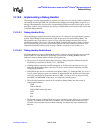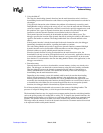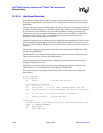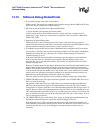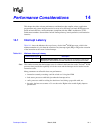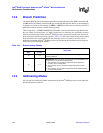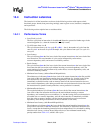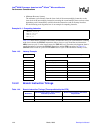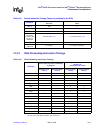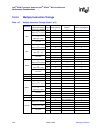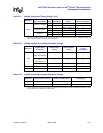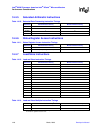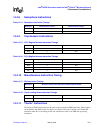
Developer’s Manual March, 2003 14-3
Intel
®
80200 Processor based on Intel
®
XScale
™
Microarchitecture
Performance Considerations
14.4 Instruction Latencies
The latencies for all the instructions are shown in the following sections with respect to their
functional groups: branch, data processing, multiply, status register access, load/store, semaphore,
and coprocessor.
The following section explains how to read these tables.
14.4.1 Performance Terms
• Issue Clock (cycle 0)
The first cycle when an instruction is decoded and
allowed to proceed to further stages in the
execution pipeline (i.e., when the instruction is actually issued).
• Cycle Distance from A to B
The cycle distance from cycle A to cycle B is (B-A) -- that is, the number of cycles from the
start of cycle A to the start of cycle B. Example: the cycle distance from cycle 3 to cycle 4 is
one cycle.
• Issue Latency
The cycle distance from the first issue clock of the current instruction to the issue clock of the
next instruction. The actual number of cycles can be influenced by cache-misses,
resource-dependency stalls, and resource availability conflicts.
• Result Latency
The cycle distance from the first issue clock of the current instruction to the issue clock of the
first instruction that can use the result without incurring a resource dependency stall. The
actual number of cycles can be influenced by cache-misses, resource-dependency stalls, and
resource availability conflicts
• Minimum Issue Latency (without Branch Misprediction)
The minimum cycle distance from the issue clock of the current instruction to the first possible
issue clock of the next instruction assuming best case conditions (i.e., that the issuing of the
next instruction is not stalled due to a resource dependency stall; the next instruction is
immediately available from the cache or memory interface; the current instruction does not
incur resource dependency stalls during execution that can not be detected at issue time; and if
the instruction uses dynamic branch prediction, correct prediction is assumed).
• Minimum Result Latency
The required minimum cycle distance from the issue clock of the current instruction to the
issue clock of the first instruction that can use the result without incurring a resource
dependency stall assuming best case conditions (i.e., that the issuing of the next instruction is
not stalled due to a resource dependency stall; the next instruction is immediately available
from the cache or memory interface; and the current instruction does not incur resource
dependency stalls during execution that can not be detected at issue time).
• Minimum Issue Latency (with Branch Misprediction)
The minimum cycle distance from the issue clock of the current branching instruction to the
first possible issue clock of the next instruction. This definition is identical to Minimum Issue
Latency except that the branching instruction has been mispredicted. It is calculated by adding
Minimum Issue Latency (without Branch Misprediction) to the minimum branch latency
penalty number from Table 14-2, which is four cycles.



